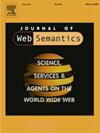On the role of knowledge graphs in AI-based scientific discovery
IF 3.1
3区 计算机科学
Q3 COMPUTER SCIENCE, ARTIFICIAL INTELLIGENCE
引用次数: 0
Abstract
Research and the scientific activity are widely seen as an area where the current trends in AI, namely the development of deep learning models (including large language models), are having an increasing impact. Indeed, the ability of such models to extrapolate from data, seemingly finding unknown patterns relating implicit features of the objects under study to their properties can, at the very least, help accelerate and scale up those studies as demonstrated in fields such as molecular biology and chemistry. Knowledge graphs, on the other hand, have more traditionally been used to organize information around the scientific activity, keeping track of existing knowledge, of conducted experiments, of interactions within the research community, etc. However, for machine learning models to be truly used as a tool for scientific advancement, we have to find ways for the knowledge implicitly gained by these models from their training to be integrated with the explicitly represented knowledge captured through knowledge graphs. Based on our experience in ongoing projects in the domain of material science, in this position paper, we discuss the role that knowledge graphs can play in new methodologies for scientific discovery. These methodologies are based on the creation of large and opaque neural models. We therefore focus on the research challenges we need to address to support aligning such neural models to knowledge graphs for them to become a knowledge-level interface to those neural models.
论知识图在人工智能科学发现中的作用
研究和科学活动被广泛视为人工智能当前趋势的一个领域,即深度学习模型(包括大型语言模型)的发展正在产生越来越大的影响。事实上,这种模型从数据中推断的能力,似乎可以找到与所研究对象的隐含特征与其属性相关的未知模式,至少可以帮助加速和扩大这些研究的规模,如分子生物学和化学等领域的研究。另一方面,知识图更传统地用于围绕科学活动组织信息,跟踪现有知识,进行的实验,研究社区内的互动等。然而,为了让机器学习模型真正成为科学进步的工具,我们必须找到方法,让这些模型从训练中隐性获得的知识与通过知识图获得的显式表示的知识相结合。根据我们在材料科学领域正在进行的项目中的经验,在本意见书中,我们讨论了知识图谱在科学发现的新方法中所起的作用。这些方法是基于创建大型且不透明的神经模型。因此,我们专注于我们需要解决的研究挑战,以支持将这些神经模型与知识图对齐,使它们成为这些神经模型的知识级接口。
本文章由计算机程序翻译,如有差异,请以英文原文为准。
求助全文
约1分钟内获得全文
求助全文
来源期刊

Journal of Web Semantics
工程技术-计算机:人工智能
CiteScore
6.20
自引率
12.00%
发文量
22
审稿时长
14.6 weeks
期刊介绍:
The Journal of Web Semantics is an interdisciplinary journal based on research and applications of various subject areas that contribute to the development of a knowledge-intensive and intelligent service Web. These areas include: knowledge technologies, ontology, agents, databases and the semantic grid, obviously disciplines like information retrieval, language technology, human-computer interaction and knowledge discovery are of major relevance as well. All aspects of the Semantic Web development are covered. The publication of large-scale experiments and their analysis is also encouraged to clearly illustrate scenarios and methods that introduce semantics into existing Web interfaces, contents and services. The journal emphasizes the publication of papers that combine theories, methods and experiments from different subject areas in order to deliver innovative semantic methods and applications.
 求助内容:
求助内容: 应助结果提醒方式:
应助结果提醒方式:


